-

人教版高中英语必修3Healthy Eating说课稿4篇
Language learning needs a context, which can help the learners to understand the language and then can product comprehensible output, so computer has the advantages to make the materials attractive.Part 3 Learning MethodsTask-based, self-dependent and cooperative learningPart 4 Teaching ProcedureStep One Lead-in“Interest is the best teacher.” Therefore, at the very beginning of the class, I should spark the students’ mind to focus on the centre topic “the band”. I’ll show some pictures of food to attract their attention and then bring some questions.Question:What kind of food they like?What should go into a good meal?The answers must relate to the diet. After this, the students will be eager to know something about a balance diet and this is the very time to naturally lead the class into Step 2Step 2 Reading for information: skimming and scanning In this step, I use Task-based Language Teaching method, which can give students a clear and specific purpose while skimming and scanning the context.Task 1 General ideaThe students will be asked to just glance at the title and the pictures of the passage, and then guess what they will read in the text. And they’ll be divided into groups of four to have a discussion.The purpose is to inspire the students to read actively, not passively. In addition, the task is to develop the students’ reading skill by making prediction and to encourage the students to express their thoughts in English and cooperate with each other.Task 2 Main idea of each paragraphCooperative learning can raise the students’ interest and create an atmosphere of achievement. Based on this theory, I divide the whole class into 4 groups to skim the whole text and get the main idea of each paragraph.

人教版高中英语必修4Working The Land说课稿3篇
Knowledge objectives:(1) to make Ss grasp the usage of words, expressions and sentence structures: statistics, struggle, thanks to, rid of, some patterns for persuasion, the “ing” form as subject and object;(2)to use learnt knowledge to persuade sb.Ability objectives:(1) to develop Ss’ reading skills(skimming, scanning, word guessing);(2) to improve Ss’ speaking, communicating and cooperating skills.Emotional objectives:to make Ss know the contribution of Yuan,and learn his spirit and his simple life time.Teaching important and difficult points:(1) some words, expressions and sentence structures mentioned above;(2)the content of the text;(3)training their reading and speaking skills.Teaching methods: CLT, TBLT,QT.Learning strategies: CLS, QLS, TBLS.Teaching procedures:Step 1 lead-in: (1) teacher plays a piece of recent news from CCTV about the harvest of the super hybrid rice, and ask students whether they know Yuan or not, and talk about him and his contribution.(2)Brain storm: let Ss describe Yuan in their minds including his appearance, his living condition and so on.Step 2 fast reading tasks:(1)teacher introduces Yuan and super hybrid rice(2)make Ss read the text as fast as possible with questions. Such as: what’s the general ideaof this passage? What’s Yuan’ dream? (skimming and scanning skill)Step 3 intensive reading tasks(1)let Ss read the text silently, find topic sentence of each paragraph and draw the difficult sentences and the knowledge what they don’t understand.(words guessing)(2)teacher and Ss talk about the important words, expressions and sentences together, and ask Ss to retell the content of the text.(summarizing and paraphrasing)(3)teacher summarize this part.(4) read again following the courseware.

人教版高中英语必修3The million pound bank note说课稿3篇
在接下来的细读环节,我套用了高考对阅读理解的考查方式设置了5个问题,分别为三个推理判断题,一个细节题和一个主旨大意题。学生需要对文章的内容进行分析、归纳、推理、猜测等高级思维活动才能做出正确的回答。【设计意图】这一过程是对学生进行细读的训练,培养学生获取特定信息和挖掘文章深层次信息的能力。第三环节:Intensive-reading (精读) 15′第三个环节精读,既是最重要的环节,也是突破本课重难点的关键。首先,让学生思考剧本中人物看到百万英镑前后的态度发生了怎样的变化。其次,让学生仔细阅读文章,找出可以表现人物态度变化的具体的语言和动作。最后,让学生总结人物的态度发生变化的根本原因是什么,从而引出Money Talks, 供学生思考。【设计意图】通过一系列的活动培养学生学习从人物的语言和动作探究人物的心理,使学生进一步体会戏剧语言的魅力,从而对文章背后所反映的社会问题进行思考,也为下一步的讨论环节做好铺垫。

人教版高中英语必修5First aid说课稿6篇
In this class, I have 3 teaching aims, that is, knowledge aims, ability aims and emotion aims.1) Knowledge-Teach students new words and expressions, such as temporary, bleed,sprain choke, first aid, fall ill and so on.-Enable students to have a better understanding for some basic knowledge of first aid.2) Ability-Train students’ speaking, reading and writing abilities by different teaching activities, such as skimming, comprehending, team work, role play, retelling and writing.-Develop students’ reading strategy on how to move general idea to specific information.3) Emotion-Promote students’ awareness of giving first aid.- Cultivate students’ creativities.Then let’s come to my teaching methods and activities.III. Teaching methods and activities:To achieve different teaching aims, various kinds of teaching methods and activities will be adopted throughout this period, such as TBL (task-based learning), skimming, team work, brainstorm and others, which can offer students opportunities to fulfill tasks in which they can use language to achieve a specific outcome.IV. Teaching aids:Computer and blackboardV. Teaching important points:1) Make students have a clear mind for the structure of the text.2) Help students understand the theme of the text.VI. Teaching difficulties:1) So many new words may affect students’ understanding.2) How to get students to know about the functions of the skin and thecauses, characteristics and treatments for different degree burns,and the knowledge about giving first aid. VII. Blackboard design:

人教版高中英语必修5Great scientists说课稿4篇
通过写文章梗概,培养学生综合运用语言的能力,学习用恰当的英语描述科学家的故事。这是本课的教学难点。教师可以使用完形填空的方式来帮助学生整理语篇,从而来降低难度。本课的教学重点的突破方法是:在阅读前,让学生初步了解得出科学观点所需要的基本程序,从而轻松而自然地导入文章的阅读;在阅读过程中,由易到难设计快速阅读和精读的问题,层层推进各种阅读活动,让学生对阅读内容从整体感知到细节理解,最后深层读懂整篇文章,同时加强阅读策略的指导,让每个学生都主动参与课堂教学活动,最终达到提高阅读能力的目的。Step 4 Post-readingGroup Activities四人小组共同合作,在老师的适当指导下,就以下2个问题展开讨论,让学生就所知、所学、所感和所想融入话题,然后抽若干同学代表作小组发言。1. What do you think about John Snow, and what should we learn from him?2. Cholera was 19th century disease, which two diseases are similar to cholera today? Why?

人教版高中英语必修5Life in the Future说课稿5篇
Good afternoon, everyone. It’s my great pleasure to be here sharing my lesson with you. The content of my lesson is Senior English for China Book5 Unit 3 Life in the Future. I’ll be ready to begin this lesson from six parts: Analysis of the teaching material, Analysis of the students, Teaching aims and important and difficult points, Teaching methods and aids, Teaching procedures, and Blackboard design. First, let me talk about the teaching material.Part 1 Analysis of the Teaching Material:This unit is about what human beings’ life will be like in about one thousand years. By studying of this unit, we’ll Enable the students to know the changes in humans’ life and some new inventions bringing about the change and develop the interest in science. This lesson plays an important part in the English teaching in this unit. This is an important lesson in Book Five. From this lesson, it starts asking the Ss to grasp contents of each passage. Therefore, this lesson is in the important position of the teaching material. If the Ss can learn it well, it will be helpful to make the Ss learn the rest of this unit.Part 2 Analysis of the SsAs Senior2 Ss, they are at different levels of English fluency, some of them have lost interest in English. So during the lesson, I arrange a variety of activities to let all of them join in to attract their interest and let them be confident and taste the joy of success.

人教版高中英语必修5Making the news说课稿4篇
今天我们来介绍一下必修五第四单元的授课方式。这个单元的题目是Making the news。应该是学生比较感兴趣的话题,学生往往对新闻工作充满好奇,所以我们可以利用这个机会多设计一些师生互动和学生互动,来激发起学习的积极性,提高学习效率。同时我们可以利用这个单元不仅帮助学生掌握语言知识,培养语言能力,同时让其了解新闻工作的重要性,培养起社会智能感。这个单元分为六个课时,它的教学目标是这样的:语言目标是掌握词汇表中的常用单词和短语,掌握倒装句的一些基本用法。 技能目标是能初步掌握约会的基本句型并在真实的场景下正确运用。新闻报道类文章的写作技能。采访的基本规范和沟通技能。情感目标是对新闻报道的客观性和真实性有更好的理解。对新闻记者的职业有更深入的了解,并能体会其工作的重要性。下面我们来介绍一下第一课时的授课方式,第一课的教学目标是这样的第一课时的教学目标语言目标:单词:Occupation, journalist, editor, photographer, curious, personality, enthusiasm

人教版高中英语必修5The United Kingdom说课稿4篇
Teaching Aims:Knowledge 1. Get the students to learn the useful new words and expressions in this section. Aims:2. Let the students learn about how the UK was formed and the four groups of invaders.1. Develop students’ reading ability and let them learn different Ability reading skills. Aims:2. Enable students to learn to talk about the United Kingdom and the Union Jack Emotional 1. Let students know more about the UK2. Develop students’ sense of cooperative learning Aims:Teaching Important Points:1. Let the students learn about the countries of the United Kingdom and the Union Jack2. Get the students to read the passage and know about how the UK was formed and the four groups of invaders.3. Have the students learn different reading skills.Teaching Difficult Ponts:1. Develop students’ reading ability.2. Enable students to talk about the United Kingdom and the Union Jack.3. Let students learn how the UK was formed geographically and historically.Teaching Methods:Showing pictures, asking, exercising, listening, reading etc.Teaching Aids:A computer,a projector and a blackboard.Teaching Procedures: 1) Show a map of the world, ask students the following questions:Where is the UK?What’s the full name of the UK?2) Ask the students work in pairs to do the quiz on Page 9.Do you want to test how many things you know about the United Kingdom? Let’s have a small test.Using the map on P9, students answer the following questions:?How many countries does the UK consist of? What are they??England is divided into three main areas. Do you know what they are? 1) Scanning (10Minutes )Let the students hold the questions asked in pre-reading and read the passagequickly and then let them do the following exercise.Join lines to the right answer.

人教版高中地理必修2煤城焦作出路何在说课稿
分析过焦作市的地理概况和产业优势后,就需要针对由于资源枯竭所带来的问题提出合理化的建议。既然是谈经济转型,就应该将话题的范围明确在这一领域内。通过材料3的相关内容,我们了解到焦作市需要在产业结构调整、培育新的优势产业、增强综合竞争力等三个整改方针上下功夫。因而引导学生针对优势与不足提出建议,以三个整改方针为基准,衡量建议的可行性是锻炼学生解决此类问题的有效途径。在此我将教会学生的是解决问题方法而非案例的内容,正所谓“授之以鱼,不如授之以渔”。接下来针对学生的建议和教材资料分析所罗列的10点整改思路,由学生自由发言提出看法,通过教师的指导和学生的讨论,进而确定经济转型建议的具体方案。最后注意将建议与产业优势相对照,看建议是否都是围绕着产业优势而提出的,这样做会加深学生的印象,通过建议和优势的对应关系,将不难找出此类问题的解题思路。
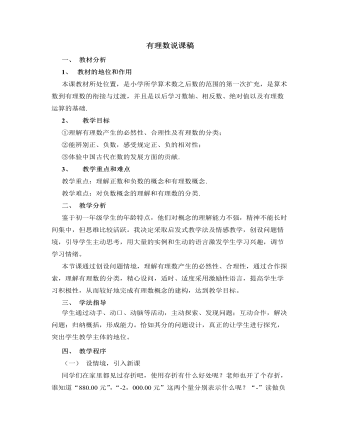
北师大初中数学七年级上册有理数说课稿
1、 教材的地位和作用本课教材所处位置,是小学所学算术数之后数的范围的第一次扩充,是算术数到有理数的衔接与过渡,并且是以后学习数轴、相反数、绝对值以及有理数运算的基础.2、 教学目标①理解有理数产生的必然性、合理性及有理数的分类;②能辨别正、负数,感受规定正、负的相对性;③体验中国古代在数的发展方面的贡献.3、 教学重点和难点教学重点:理解正数和负数的概念和有理数概念.教学难点:对负数概念的理解和有理数的分类.二、 教学分析鉴于初一年级学生的年龄特点,他们对概念的理解能力不强,精神不能长时间集中,但思维比较活跃。我决定采取启发式教学法及情感教学,创设问题情境,引导学生主动思考,用大量的实例和生动的语言激发学生学习兴趣,调节学习情绪。
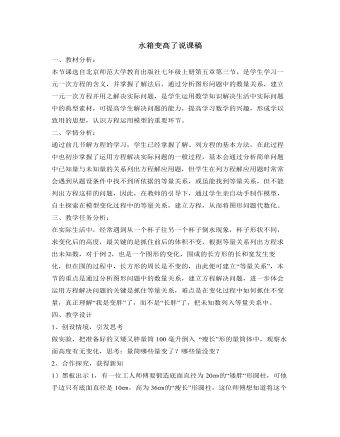
北师大初中数学七年级上册水箱变高了说课稿
一、教材分析:本节课选自北京师范大学教育出版社七年级上册第五章第三节,是学生学习一元一次方程的含义,并掌握了解法后,通过分析图形问题中的数量关系,建立一元一次方程并用之解决实际问题,是学生运用数学知识解决生活中实际问题中的典型素材,可提高学生解决问题的能力,提高学习数学的兴趣,形成学以致用的思想,认识方程运用模型的重要环节。二、学情分析:通过前几节解方程的学习,学生已经掌握了解、列方程的基本方法,在此过程中也初步掌握了运用方程解决实际问题的一般过程,基本会通过分析简单问题中已知量与未知量的关系列出方程解应用题,但学生在列方程解应用题时常常会遇到从题设条件中找不到所依据的等量关系,或虽能找到等量关系,但不能列出方程这样的问题,因此,在教师的引导下,通过学生亲自动手制作模型,自主探索在模型变化过程中的等量关系,建立方程,从而将图形问题代数化。
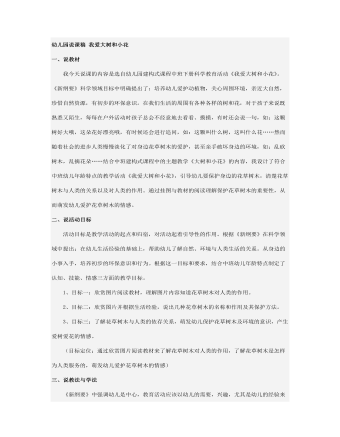
幼儿园说课稿 我爱大树和小花
我今天说课的内容是选自幼儿园建构式课程中班下册科学教育活动《我爱大树和小花》。《新纲要》科学领域目标中明确提出了:培养幼儿爱护动植物,关心周围环境,亲近大自然,珍惜自然资源,有初步的环保意识。在我们生活的周围有各种各样的树和花,对于孩子来说既熟悉又陌生,每每在户外活动时孩子总会不经意地去看看、摸摸,有时还会说一句,如:这颗树好大哦,这朵花好漂亮哦,有时候还会进行追问,如:这颗叫什么树,这叫什么花……然而随着社会的进步人类慢慢淡化了对身边花草树木的爱护,甚至亲手破坏身边的环境,如:乱砍树木,乱摘花朵……结合中班建构式课程中的主题教学《大树和小花》的内容,我设计了符合中班幼儿年龄特点的教学活动《我爱大树和小花》,引导幼儿要保护身边的花草树木,清楚花草树木与人类的关系以及对人类的作用。通过挂图与教材的阅读理解保护花草树木的重要性,从而萌发幼儿爱护花草树木的情感。
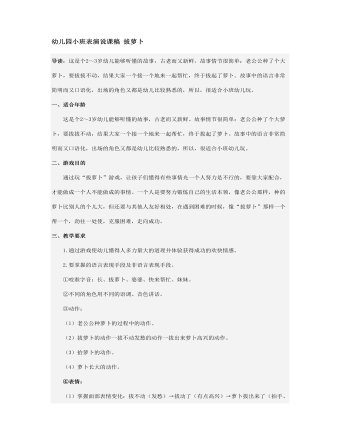
幼儿园小班表演说课稿 拔萝卜
1、让孩子们熟悉故事? 一听:听家长和老师讲,也可以听录音带,有些地方可反复讲、放。 二讲:让孩子们复述故事。 三熟悉:先让孩子们一起一段一段地把故事讲完整,然后以个人或角色小组为单位,配合讲出完整的故事。? 2、示范表演 老师先扮老公公,然后再扮老婆婆,这样一一地把角色的动作和语言给孩子们示范一遍,示范时要注意紧紧抓住各角色的典型特征,如老公公走路和小弟弟、小花狗走路就不一样,但动作应宁简勿繁,以利孩子模仿。 3、自由试演 让小朋友们自由搭配成小组,自由尝试表演各种角色,家长或老师在鼓励的同时作适当的指点。 表演的要点有:各角色动作的典型特征,说话的声音特征,想拔出萝卜的渴望,拔不出萝卜的焦急,盼望帮助的急切和帮忙者的热情,拔出萝卜后的高兴等等。 4、观摩表演 即正式妆扮好分组表演,家长或老师以及不上场的小朋友一起观看。在观摩中可对出场次序、对话、表演等方面进行一定的提示,但应充分鼓励孩子的自由发挥。另外,在表演中加入音乐或音响效果,更能增加游戏气氛。
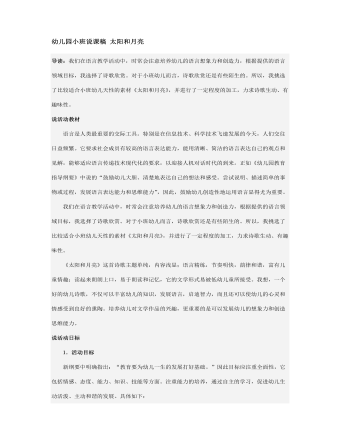
幼儿园小班说课稿 太阳和月亮
语言是人类最重要的交际工具。特别是在信息技术、科学技术飞速发展的今天,人们交往日益频繁。它要求社会成员有较高的语言表达能力,能用清晰、简洁的语言表达自己的观点和见解,能够适应语言传递技术现代化的要求,以迎接人机对话时代的到来。正如《幼儿园教育指导纲要》中说的“鼓励幼儿大胆、清楚地表达自己的想法和感受。尝试说明、描述简单的事物或过程,发展语言表达能力和思维能力”,因此,鼓励幼儿创造性地运用语言显得尤为重要。 我们在语言教学活动中,时常会注意培养幼儿的语言想象力和创造力,根据提供的语言领域目标,我选择了诗歌欣赏。对于小班幼儿而言,诗歌欣赏还是有些陌生的。所以,我挑选了比较适合小班幼儿天性的素材《太阳和月亮》,并进行了一定程度的加工,力求诗歌生动、有趣味性。 《太阳和月亮》这首诗歌主题单纯,内容浅显;语言精练,节奏明快,韵律和谐,富有儿童情趣;读起来朗朗上口,易于朗读和记忆,它的文学形式易被低幼儿童所接受。我想,一个好的幼儿诗歌,不仅可以丰富幼儿的知识,发展语言,启迪智力,而且还可以使幼儿的心灵和情感受到良好的熏陶。培养幼儿对文学作品的兴趣,更重要的是可以发展幼儿的想象力和创造思维能力。
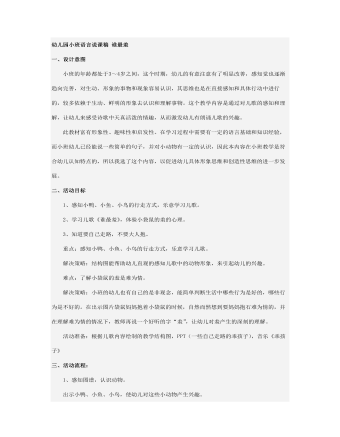
幼儿园小班语言说课稿 谁最羞
1、感知小鸭、小鱼、小鸟的行走方式,乐意学习儿歌。 2、学习儿歌《谁最羞》,体验小袋鼠的羞的心理。 3、知道要自己走路,不要大人抱。 重点:感知小鸭、小鱼、小鸟的行走方式,乐意学习儿歌。 解决策略:结构图能帮助幼儿直观的感知儿歌中的动物形象,来引起幼儿的兴趣。 难点:了解小袋鼠的羞是难为情。 解决策略:小班的幼儿也有自己的是非观念,能简单判断生活中哪些行为是好的,哪些行为是不好的。在出示图片袋鼠妈妈抱着小袋鼠的时候,自然而然想到要妈妈抱石难为情的,并在理解难为情的情况下,教师再说一个好听的字“羞”,让幼儿对羞产生的深刻的理解。 活动准备:根据儿歌内容绘制的教学结构图,PPT(一些自己走路的乖孩子),音乐《乖孩子》
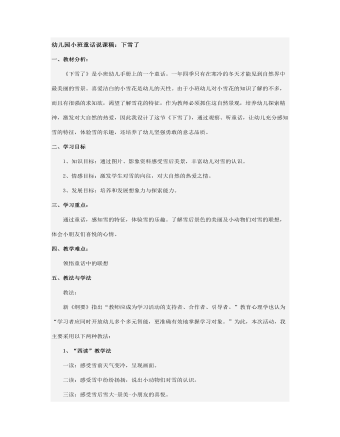
幼儿园小班童话说课稿:下雪了
1、创设情境,激趣导入 先谈话导入“小朋友们现在是什么季节,天气冷吗?”。 事先准备好“雪花”(泡沫削)放在有缝隙的篮子里,篮子放在空调吹风出,打开空调,雪花从天而降,“小朋友们快看,天上飘落了什么?”幼儿一定会兴奋地说道下雪了。“你们喜欢下雪吗?接着播放《雪绒花》音乐,让幼儿回忆下雪时的情景,在柔美的音乐中轻柔飘舞,此时注意不能让幼儿太兴奋以免影响下面活动的发展,而因静静地带他们在座位上飞舞轻柔地使他们安静下来。2、欣赏探索 首先出示《下雪了》图片,引导幼儿欣赏图片,幼儿对新的刺激物很感兴趣,看到图片会自由的说出看到的东西,此时我把一分钟留给幼儿,让他们说说自己看到的。 讲童话部分,我决定运用“四读”法有感情的讲童话。
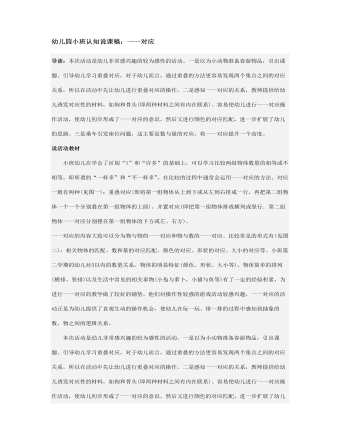
幼儿园小班认知说课稿:一一对应
小班幼儿在学会了区别“l”和“许多”的基础上,可以学习比较两组物体数量的相等或不相等,即所谓的“一样多”和“不一样多”。在比较的过程中通常会运用一一对应的方法。对应一般有两种(见图一):重叠对应(即将第一组物体从上到下或从左到右排成一行,再把第二组物体一个一个分别叠在第一组物体的上面)。并置对应(即把第一组物体排成横列或竖行.第二组物体一一对应分别摆在第一组物体的下方或左、右方)。一一对应的内容大致可以分为物与物的一一对应和物与数的一一对应。比较常见的形式有(见图二):相关物体的匹配、数和量的对应匹配、颜色的对应、形状的对应、大小的对应等。小班第二学期的幼儿对5以内的数量关系、物体的明显特征(颜色、形状、大小等)、物体简单的排列(横排、竖排)以及生活中常见的相关事物(小兔与萝卜,小猫与鱼等)有了一定的经验积累,为进行一一对应的教学做了较好的铺垫。他们对操作性较强的游戏活动较感兴趣,一一对应的活动正是为幼儿提供了直观生动的操作机会,使幼儿在玩一玩、排一排的过程中感知到抽象的数、物之间的逻辑关系。

幼儿园小班科学说课稿 手机
“幼儿关注和发现生活中的科技成果。”这个目标属于科学领域的范畴。《纲要》中提出:从生活或媒体中幼儿熟悉的科技成果入手,引导幼儿感受科学技术对生活的影响,培养他们对科学的兴趣和对科学家的崇敬。这里提到了几个关键词:生活、熟悉,可见我们选择的科技成果的内容应该是从孩子的生活出发,为幼儿所熟悉的。 根据这个指导思想,我选择了“手机”,因为现在的家庭中至少有两部手机,有的甚至更多,孩子用手机打过电话、拍过照片、玩过游戏、听过音乐,他们对手机有一定感性认识,教师把课的重点定位在引导幼儿感受科学技术对生活的影响。 手机作为现代科技成果有着自己独特的功能,它相比于固定电话在外形上更为轻巧,携带方便,使人们随时随地都可以使用它,在功能上比固定电话更为齐全,除了最大的功能:打电话外,还附加了照相机、摄像机、随身听、游戏机、闹钟,甚至电脑的功能。但作为小班第一学期进行的教学内容,我选择了幼儿最为熟悉的两大功能:打电话与拍照入手,引导幼儿去关注和发现手机的其它功能,让孩子感受科学技术对生活的影响。
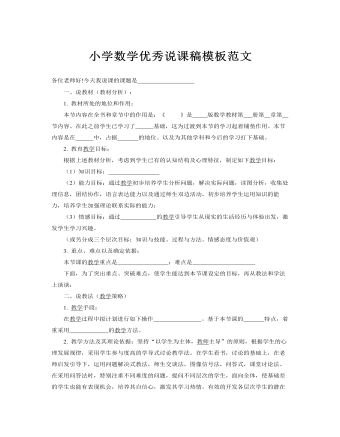
小学数学优秀说课稿模板范文
一、说教材(教材分析): 1. 教材所处的地位和作用: 本节内容在全书和章节中的作用是:《 》是 版数学教材第 册第 章第 节内容。在此之前学生已学习了 基础,这为过渡到本节的学习起着铺垫作用。本节内容是在 中,占据 的地位。以及为其他学科和今后的学习打下基础。2. 教育教学目标: 根据上述教材分析,考虑到学生已有的认知结构及心理特征,制定如下教学目标: (1)知识目标: (2)能力目标:通过教学初步培养学生分析问题,解决实际问题,读图分析,收集处理信息,团结协作,语言表达能力以及通过师生双边活动,初步培养学生运用知识的能力,培养学生加强理论联系实际的能力;
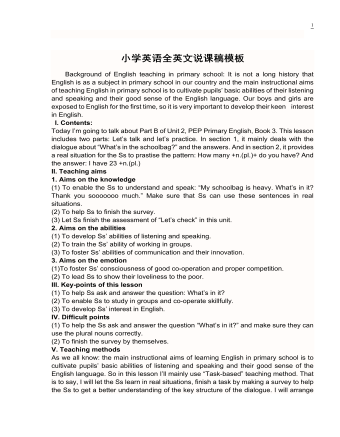
小学英语全英文说课稿模板
1. Aims on the knowledge(1) To enable the Ss tounderstand and speak: “My schoolbag is heavy. What’s in it? Thank you sooooooomuch.” Make sure that Ss can use these sentences in real situations.(2) To help Ss to finish thesurvey.(3) Let Ss finish theassessment of “Let’s check” in this unit.2. Aims on the abilities(1) To develop Ss’ abilitiesof listening and speaking.(2) To train the Ss’ abilityof working in groups.(3) To foster Ss’ abilities ofcommunication and their innovation. 3. Aims on the emotion(1)To foster Ss’ consciousnessof good co-operation and proper competition.(2) To lead Ss to show theirloveliness to the poor.